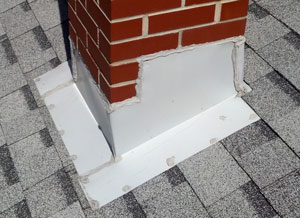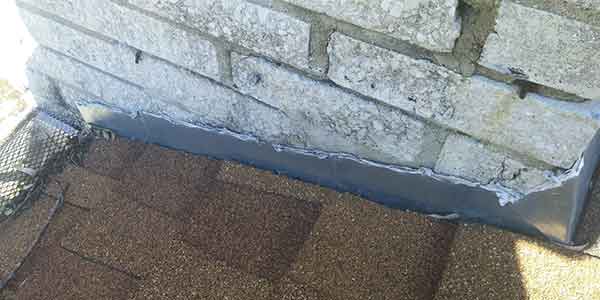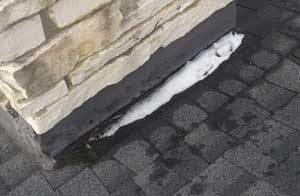Bad or Incorrect Chimney Flashings Causing a Water Leak
Disclaimer:
These problems are meant to be examples of the common ways chimneys can leak from my past experiences. Any of these examples or none of these examples may apply to your chimney. Always contact a licensed chimney expert for your particular chimney leaking problems.

Chimney flashing is the metal that joins the roof to the chimney. It should be installed in a way that water runs down the flashing and is unable to get under the flashing, just like your roofing materials. Chimney flashings are typically made from a durable material, then often sealed with a flexible sealant such as tar, silicone, polyeurathane...etc.
One of the first things that can cause a flashing to leak is the seal around the flashing. Over time most sealants can crack and allow water to enter into the chimney.

"The sealant between the flashing and chimney has failed"
Chimney flashing can be made from galvanized steel, stainless steel, copper, lead, aluminum or even vinyl. The most common type used in older homes in this area is galvanized steel. Galvanized steel will hold up for a number of years, but eventually, due to the extreme weather climates, it is subject to rust and expansion issues. Holes can rust into the flashing cause your chimney to leak water.

"Saddle flashing help prevent water and/or ice building up behind the chimney"
Another way the chimney flashing can leak is incorrect installation. The chimney flashing should be installed into a groove cut into the brick and sealed with a high grade sealant. We often find that the flashing has not be cut in. This can allow water that penetrates the brick and mortar to seep in right behind the flashing and into the house. In addition, chimneys that are very wide where the down slope of the roof meets the chimney should have a "saddle flashing" or "chimney cricket" installed to force water around the chimney structure instead of pooling up or "damming" behind the chimney and getting under the shingles.
Common Solutions to Leaking Chimney Flashing:
Bad chimney flashing seals
If your flashing seals are bad or need to be resealed. It is often resealed with an sealant such as polyurathane, silicone, roof-tar or a product such as Saver Systems Chimney Saver Flash Seal
Bad or Rusted Chimney Flashing
If the chimney flashing is not installed correctly or is rusted, it is often recommeded to have a qualified professional install proper, cut- in chimney flashing and counter flashing on the chimney.
Lack of Chimney Cricket or Saddle
If the chimney is experiencing water "damming" behind the chimney, it is often recommended to have a qualified professional install a new cricket or saddle behind the chimney to the roof.
